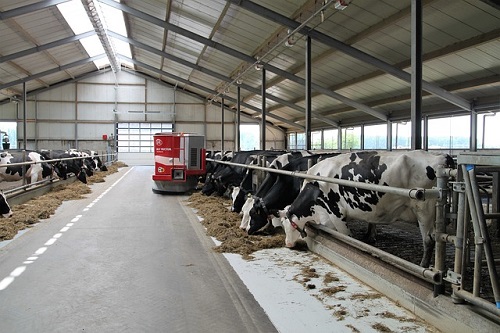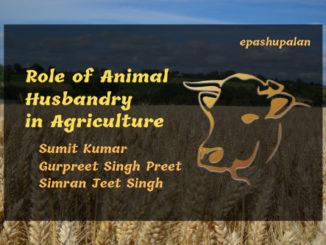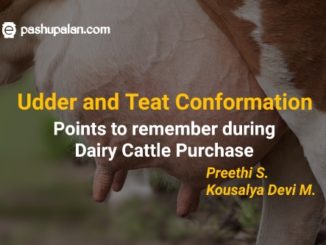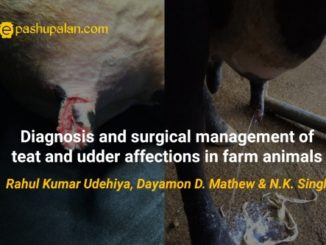Animal husbandry continues to be an integral part of human life since the process of civilization started. India has vast livestock resources and the livestock sector contributes 4.11% of Gross Domestic Product and 25.6% of total Agriculture Gross Domestic Product. The total livestock population is 535.78 million in the country showing an increase of 4.6% over Livestock census 2012. Total cattle and buffalo population in the country is 192.49 million and 109.85 million during 2019, respectively. About 36% of the total livestock is contributed by cattle and 20.5% is contributed by buffaloes (Livestock census, 2019). Although India ranks first in milk production but still per animal milk production is low in comparison with other countries. So, we need to adopt good management practices to improve per animal production. The objective for good dairy farming practice is that safe, good quality and more milk can be produced from healthy animals using management practices that are sustainable from an animal welfare, social, economic and environmental perspective. Here we will start with component of farms and will discuss how to carry out other practices at best level.
1. COMPONENTS OF FARM
-
LOCATION FOR DAIRY CATTLE FARMS
Farm shall be located in an appropriate area for good dairy cow rearing management, such as the area with convenient transportation, good drainage; and permitted by the Local Administrative Office.
Farm shall be located in an environment with minimal risk from any contamination of physical, chemical and biological hazards which may adversely affect the sanitary of dairy cattle and raw milk, such as not being in vicinity of industrial area or waste disposal site. The history of farm land shall be investigated before establishing the farm.
Farm shall be located at least 5 km from community, slaughterhouse and live animal market and able to prevent animal disease spreading from outside into the farm.
Farm shall be located close to milk collecting centre in order to conveniently deliver raw milk with good quality and receive proper services from milk collecting centre. The distance between dairy cattle farm and milk collecting centre shall not be more than 20 km.
-
LAYOUT
Farm shall have sufficient and suitable size for dairy cattle rearing and not pose any problem to environment and animal health. Farm shall have surrounding fences and one entrance and exit.
Farm shall have a good layout with area separation in accordance with the operations. The housing area for dairy cows, calves, young cattle and heifers, and the storage area for feed and veterinary drugs shall be separated and protected from pets, such as dog and cat that may be disease carriers.
Farm shall be an open area with good air flow; and have appropriate pasture area and adequate shades. A The owner shall legally own the farm or have the land use right.
Accommodation and office shall be located only in the residential area, where they are distinctly segregated from dairy cattle rearing area. No dwelling shall be in area of dairy cattle houses. Accommodation shall be well constructed, clean and tidy.
-
HOUSING
Stall of a dairy cow shall have a minimum area of 4 m 2 (square meter) per head. Housing shall be well constructed using durable materials that are easy to be cleaned and maintained. It shall not cause any harm to animals and workers. Housing can prevent animals from sunlight and rain.
Floor of milking area shall be made from non-slippery concrete, slightly tilted with good drainage to prevent waste accumulation within the house. It shall be lifted up from the ground as same as the dairy cattle house floor and installed with an effective waste drain to prevent waste accumulation which may be the source of pathogens.
Roof of housing shall be elevated with the eaves above the ground of at least 3 m (meter) for good ventilation with no construction or object obstructing the air flow.
Appropriate and adequate feed and water troughs shall be designed to facilitate cleaning in each house. The floor area connecting to the feeding trough, where dairy cattle stand during feeding, shall be made of concrete with the width of not less than 1.5 m to facilitate cleaning.
There shall be adequate light for operation. If natural light is not enough, electric light shall be provided to facilitate animal caring and health check at all times. Emergency light shall be provided in case of power failure.
Equipment and tools for farm operation shall be in good condition, adequate, and cause no harm to dairy cattle. Separate storage shall be provided for equipment and tools that are easily cleaned, operated, and cause no contamination to milk.

2. FEED
Quality and standard of dairy cattle feed shall be complied with the Feed Quality Control Act.
Feed shall be purchased from licensed suppliers according to the Feed Quality Control Act.
In case of self-mixed feed, feed ingredients and additives used shall be of good quality. The prohibited substances according to the Feed Quality Control Act and all veterinary drugs shall not be used.
Feed containers shall be clean, dry, in good condition with moisture proof. They shall never have contained hazardous substances, fertilizers, or other harmful materials to animals. The containers shall be free from any contaminant. If coated with other substances, such substance shall not be harmful to animals and shall have proper label.
Truck used for feed delivery, particularly loaded section shall be cleaned and dried without any leftover materials.
Physical properties of feed shall be preliminary checked such as no rupture of container, correct label. Feed contaminated with fungus shall be rejected and properly eliminated. Feed shall be sampled for further laboratory test in case of any problem found.
Feed quality shall be randomly sampled and examined for feed quality and residues by the Department of Livestock Development, according to the Feed Quality Control Act. The test results shall be kept and ready for further inspection.
Separate storage shall be provided for feed that is clean, dry, and free from insects and animals. The feed storage can maintain the quality from deterioration. If feed is contained in bags, they shall be placed on pallets for good ventilation.
Good quality roughage shall be sufficiently provided to meet the need of dairy cattle and in an appropriate ratio to the concentrate feed corresponding to the age and breed of the animals.Feeding containers or tools shall be clean and adequate.
3. WATER SUPPLY
Water source used on farm shall be distance away from an area contaminated by animal manure or waste water from cattle house or residential areas. Furthermore, water source shall be away from slaughterhouses or industrial factories. If water is supplied from underground, the artesian well shall be completely covered.
Adequate drinking water shall be provided to dairy cattle. Water used for animal and farm shall be clear, clean and free from suspended matters.
Water used for cleaning teats and udders of dairy cows and for equipment and tools used in direct contact with milk shall be clean with appropriate hardness. Water quality shall comply with the potable water standard under the Notification of the Ministry. Watering containers or tools shall be clean and adequate.
4. FARM MANAGEMENT
4.1 Farm manual
Farm management manual shall be provided to illustrate details of animal rearing, farm management, animal feeding, animal disease prevention and control, animal health care, farm sanitary, documentation and record system and the precautions of dairy cows on each stage of operation in order to evaluate the effectiveness of dairy cattle farm as follows: (1) newborn calves to weaning; (2) young cattle and heifers (from weaning to breeding); (3) pregnant cows; (4) milking cows; (5) dry cows.
4.2 Personnel
Farm shall have enough personnel according to the number of dairy cattle. The number of personnel may depend on many factors such as type of housing, animal rearing system, equipment and other facilities available on farm. Persons responsible for dairy cattle shall be trained on dairy cattle rearing from recognised institute or agency. They shall acquire good knowledge and skill in taking care of dairy cattle and shall be continuously trained and developed. Training shall be recorded in each individual file.
There is a farm veterinarian supervising animal health and farm hygiene and giving proper advice on disease prevention, treatment, and drug use within the farm. The farm veterinarian is the one who possesses the veterinary license of Veterinary Council and the dairy cattle farm veterinary supervisor license issued by the Department of Livestock Development.
Every person working in dairy farm shall have annual health checkup and have no tuberculosis infection. A Persons who work in the farm shall follow good personal hygiene practices, i.e. dressing with clean clothes, washing and drying hands every time prior to the operation, keeping hands and nails clean, no smoking, no spitting, coughing, sneezing or chewing and eating during operation.
4.3 Cleaning and maintenance
Housing, equipment and feed and water troughs shall be cleaned regularly to remove leftover feed, fungi or accumulated manure. The immediate areas of housing shall be cleaned and mowed to prevent harbouring of pathogens or disease-carrier insects. Milking house and surrounding area as well as the equipment and tools shall be regularly cleaned. Housing and equipment shall be hygienic for the convenience and safe operation. Automatic milking tools and equipment shall be daily cleaned and checked. If there are malfunctions or expiry of use, corrective action shall be taken immediately.
5 ANIMAL HEALTH
5.1 Prevention and control of diseases
Effective disease surveillance, prevention and control shall be carried out as follows:
(1) A system of pathogen elimination before entering and leaving farm shall be strictly enforced. There shall be disinfectant spraying facilities or wheel dips. Keep record of visitors and vehicles in and out of the farm for inspection
(2) Limit non-essential visitors to the farm, for example there shall be fences around the rearing area or a warning sign no trespassing on site for unauthorized persons and vehicles.
(3) Dairy cattle shall be routinely tested for tuberculosis and brucellosis at least once a year by the Department of Livestock Development.
(4) Program for vaccination against Foot and Mouth Disease and Hemorrhagic Septicemia and program for elimination of internal and external parasites by the Department of Livestock Development shall be provided. Hoof trimming shall be provided for lame cattle to walk normally without suffering.
(5) Prevention and control of pests shall be in place to avoid the harbouring source of pathogens that affect health and hygienic conditions i.e. no water logging or sewage around the cattle house, which can harbour various insects. In addition, programs for prevention and control shall be continuously and regularly implemented.
(6) There shall be a proper management procedure on sick animal, dead animal and destruction of carcass in order to quickly control the disease and its spread out from the farm. If the farm veterinarian advises to dispose the carcass, it shall be buried at the depth of not less than 50 cm. Proper disinfectants shall be poured or scattered over every part of the carcass, then the pit shall be filled and piled up above the ground of at least 50 cm.
Source of dairy cattle shall be identified. Newly purchased dairy cattle shall be quarantined and health certified by the farm veterinarian. The acquisition of dairy cattle shall be investigated before introduction into the herd and ensured that such cattle shall be free from infectious diseases. The details of dairy cattle history shall be known for the benefits of further farm management.
Health of dairy cattle shall be daily monitored and checked for any abnormalities e.g. disease symptom, animal performance. A If epidemic disease occurs, local veterinary official shall be notified; and the procedures under the Animal Epidemic Act shall be implemented.
5.2 Treatment
The farm veterinarian shall practice according to the Veterinary Profession Act. Disease treatment and use of veterinary drugs, and hazardous substances shall be under the supervision of the farm veterinarian or the authorised person. For the use of veterinary drug, the farm veterinarian shall recommend with a written prescription and ensure that the use of veterinary drug is recorded. The farm veterinarian shall also take into consideration of the residues in milk especially antibiotics, anthelmintics and others.
6 ANIMAL WELFARE
Dairy cattle shall be moved freely and live in comfort and safe conditions.
Dairy cattle health shall be regularly checked at appropriate interval. Immediate action for sick, injured or deformed animals shall be properly handled to avoid suffering.
7 ENVIRONMENT
Garbage containers shall be tightly closed. Garbage shall be collected and disposed of at the designated area provided by the municipal or Local Administration Office or destroyed in the specified waste disposal area located separately from the rearing area.
Animal manure shall be removed from housing to avoid accumulation to be a source of bad odour and pathogens.
In case where effluent discharged to public water, appropriate waste water treatment device shall be provided and the quality of the discharged water shall be complied with the official standards.
8 RAW MILK PRODUCTION
8.1 Milkers
In case of being sick or suspicious of being sick or disease carrier to milk e.g. jaundice, diarrhea, vomit, sore throat, fever, skin infection, nasal discharge, otorrhea or sore eye, such milker shall not be allowed to enter the area where milking or milk handling is taken place. If the milker has symptom of sickness or epidemic disease, the milker shall have health checked before milking or handling of milk. The milker shall follow good personal hygiene practices, those include clean clothes, washing both hands and arms to elbows and drying before milking, keeping hands and nails clean and hygienic, no smoking, no spitting, coughing or sneezing or chewing and eating during working.
8.2 Preparation of dairy cows before milking
Before milking, dairy cow udders, teats, medial sides of hind legs, shanks and abdomen shall be cleaned with clean water. Disinfection of udders with disinfectant shall be done every time before milking. Before a dairy cow is milked, the foremilk shall be extracted two to three times and dropping into milk test container to check for abnormalities and to reduce germs at teat tips. Routine check for mastitis using CMT (California Mastitis Test) shall be carried out before milking every time, every cow and every udder. Dairy cow with CMT positive, such cow shall be milked at the last order and milked completely, and the milk shall not be used for consumption and sale. After milking, milk from individual cow shall be weighed and recorded each time of the day. If dairy cow is treated with the veterinary drug, withdrawal period of such drug shall be observed and sample shall be tested for antibiotic residues before sale.
8.3 Milking
Good milking techniques shall be practiced either milking by hand or machine. It is necessary to treat the teats in teat dipping solution every time after each milking and avoid injury to teats and udders. During milking, milk shall be prevented from environmental contamination, manure or dust from feeding or bedding. Tools and containers used for raw milk shall be clean, without musty smell, and have smooth surface, seamless and no reaction with milk. After each milking, equipment, tools and containers shall be thoroughly cleaned and disinfected, and dried as appropriate. If detergent and disinfectant is applied, the equipment, tools and containers shall be rinsed again with clean water, except rinsing is not required according to the label instruction. If milking machine is used, the components of machine shall be disassembled for cleaning e.g., air control valve in milk collecting cup, liner rubber, to prevent accumulation of microorganisms.
Milking equipment and air pipes shall be cleaned to prevent milk remained inside and become a source of microorganisms. The components of milking machine shall be regularly checked for its appropriate working condition to ensure that it will not cause injury to teats and udders during milking. Parts shall be changed when their expiry are due.
8.4 Raw milk delivery
After milking is complete, if it is not possible to cool down raw milk to 4 o C (degree Celsius) at farm, it shall be immediately collected and transported to milk collecting center or dairy processing plant within one hour or processed as fast as possible. Raw milk containers shall not be left stand under sunlight but placed under shade.
Raw milk deliverer shall follow good personal hygienic practices, wear clean clothes, and regularly clean milk delivering vehicle. After delivery of raw milk, containers shall be cleaned, disinfected, dried and kept in dry and clean place that can prevent insects, rodents and dust for next use.
9 RECORDS KEEPING
There shall be a system of documentation. The records of important information shall be kept for at least three years for the purpose of tracibility. They shall cover the following items:
- The information on farm management i.e., personnel information, training, health status
- The information on production management i.e., history of each dairy cow (keeping cow history record throughout the animal life), feed and water, farm management, animal heath, production records and test results of raw milk quality (report of such raw milk quality test shall be obtained from milk collecting center or the Department of Livestock Development).





